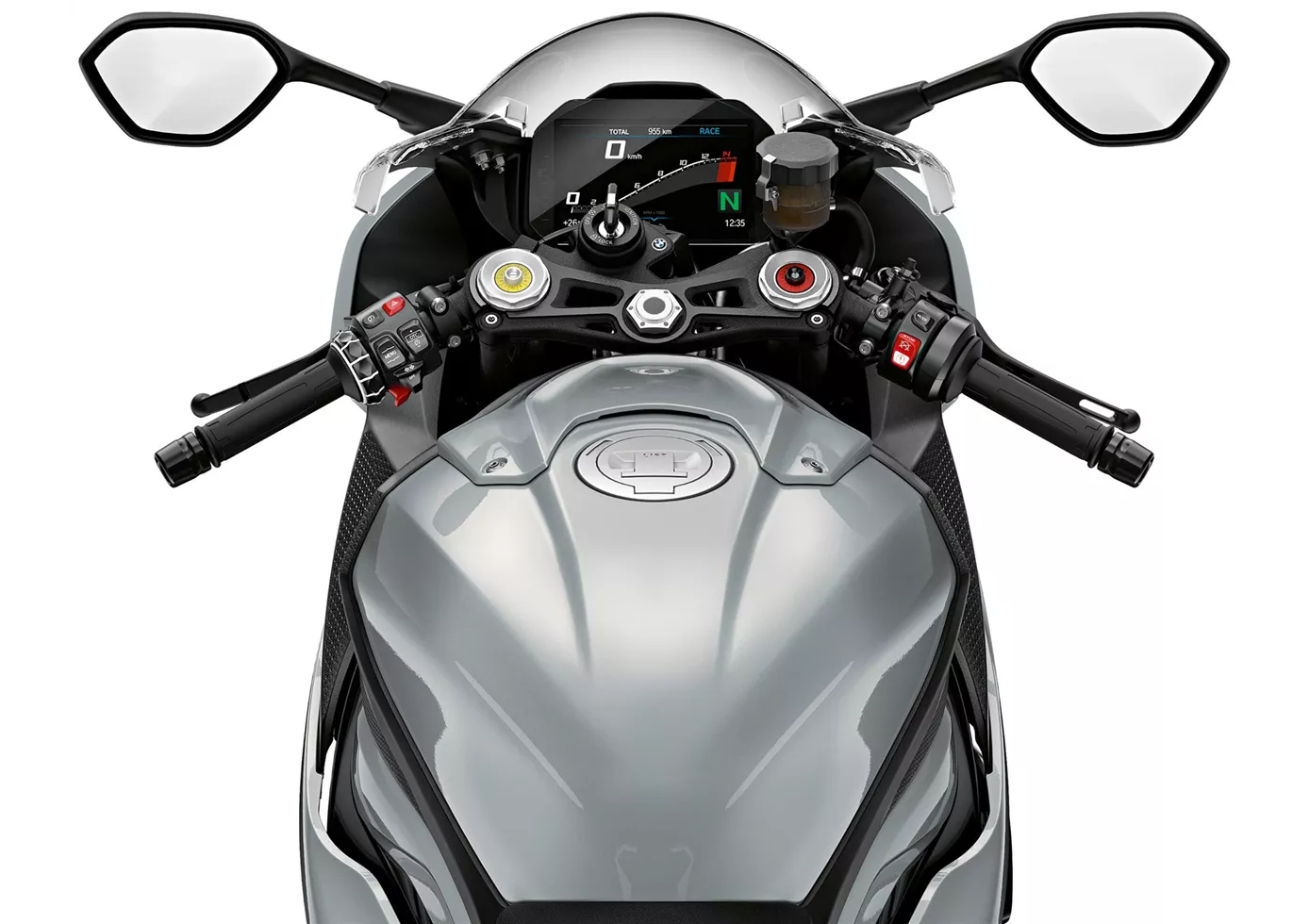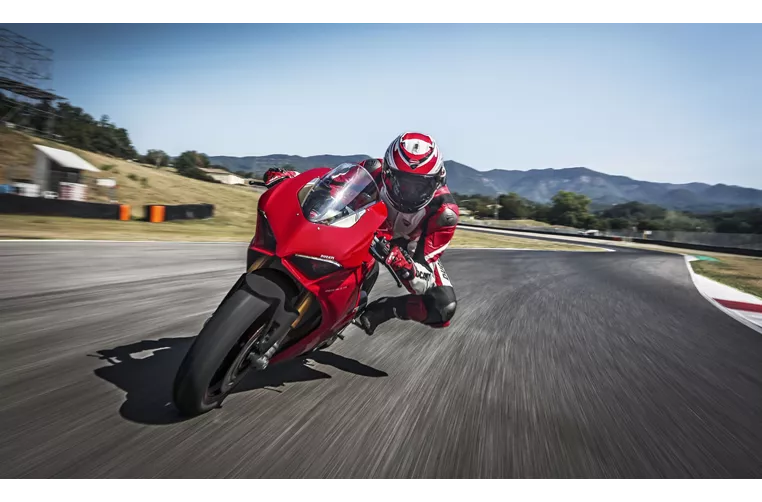Ducati Panigale V4 S 2018 vs. BMW S 1000 RR 2020

Ducati Panigale V4 S 2018

BMW S 1000 RR 2020
Visão geral - Ducati Panigale V4 S 2018 vs BMW S 1000 RR 2020
The Ducati Panigale V4 S 2018 and the BMW S 1000 RR 2020 are both high-performance supersport motorcycles that offer impressive power and advanced technology.
In terms of the engine and drivetrain, the Ducati Panigale V4 S 2018 features a V-type engine with a displacement of 1103cc. It produces a powerful 214 HP and 124 Nm of torque, with a compression ratio of 14. The BMW S 1000 RR 2020, on the other hand, has an inline engine with a displacement of 999cc. It delivers 207 HP and 113 Nm of torque, with a compression ratio of 13.3. Both motorcycles have four cylinders and four valves per cylinder, but the Ducati uses a Desmodromic valve system while the BMW uses a DOHC system.
In terms of suspension, both motorcycles feature a telescopic fork at the front and a monoshock at the rear. The Ducati has a 43mm front fork and the BMW has a slightly larger 45mm front fork. Both suspensions offer adjustment options for compression, preload, and rebound. The rear suspension on both bikes is made of aluminum.

Ducati Panigale V4 S 2018
In terms of chassis, both motorcycles have an aluminum frame. The Ducati uses a monocoque frame design, while the BMW has a dual-tube frame with a load-bearing engine. The rake angle on the Ducati is 65.5 degrees, while the BMW has a slightly steeper 66.9-degree rake angle. The trail on the Ducati is 100mm, while the BMW has a narrower 93.9mm trail.
Both motorcycles feature dual disc brakes at the front, but the Ducati has larger 330mm discs compared to the BMW's 320mm discs. The Ducati also uses radial monobloc calipers, while the BMW uses radial calipers. Both motorcycles are equipped with ABS for advanced rider assistance.
In terms of dimensions and weights, the Ducati has a wider front tire at 120mm compared to the BMW's 120mm front tire. The rear tire on the Ducati is also wider at 200mm compared to the BMW's 190mm rear tire. The Ducati has a longer wheelbase at 1469mm, while the BMW has a slightly shorter 1441mm wheelbase. The seat height on the Ducati is 830mm, while the BMW has a slightly lower 824mm seat height. Both motorcycles have a fuel capacity of around 16 liters. The Ducati weighs 195kg (with ABS), while the BMW weighs slightly more at 197kg (with ABS).
Both motorcycles are equipped with LED headlights for improved visibility.

BMW S 1000 RR 2020
In terms of strengths, the Ducati Panigale V4 S 2018 is known for its dreambike image, excellent brakes, comfortable seating position, and impressive lean angle potential. It also has a leading electronic package and a finely controllable yet powerful engine. The BMW S 1000 RR 2020, on the other hand, offers a very linear power delivery, a wide range of revs, and a pleasant control thanks to its ShiftCam technology. It also has excellent Dynamic Damping Control (DDC) and a well-rounded electronic package.
In terms of weaknesses, the Ducati Panigale V4 S 2018 can have a heated seat, which can be uncomfortable in summer. The seat-tank combination also offers little grip during braking, and stability at the limit requires careful tuning and discipline with the seating position. The BMW S 1000 RR 2020, on the other hand, may lack character compared to other bikes in its class and falls slightly behind in direct specification comparisons.
Overall, both the Ducati Panigale V4 S 2018 and the BMW S 1000 RR 2020 are impressive supersport motorcycles with their own strengths and weaknesses. The choice between the two would depend on personal preferences and priorities, such as brand preference, riding style, and desired features.
Especificações técnicas Ducati Panigale V4 S 2018 em comparação com BMW S 1000 RR 2020
Prós e contras em comparação
Prós e contras em comparação
Ducati Panigale V4 S 2018

A versão S, por outro lado, é recomendada tanto para pilotos de estrada como para pilotos de competição. Se a moto for conduzida de forma mais ambiciosa por um piloto em pista, a suspensão manterá o seu desempenho durante mais tempo do que na versão básica, pelo que se recomenda um ligeiro ajuste da taxa de mola dianteira (para pilotos). As jantes mais leves têm um efeito percetível no comportamento. É inacreditável o elevado nível de inovação e tecnologia na construção de motas a que esta moto foi elevada. Nunca experimentei uma eletrónica que respondesse de forma tão sensível.
BMW S 1000 RR 2020

Uma verdadeira superbike "polivalente". A BMW sabe como jogar com os seus pontos fortes tanto na pista de corrida como na estrada rural. Graças ao controlo variável da árvore de cames, o potente motor já convence na parte inferior e acelera harmoniosamente em toda a gama de rotações, com muita potência em todas as gamas. Para o piloto amador, o chassis funciona de forma excelente em todas as situações, proporciona um feedback transparente e oferece muitas opções de ajuste. A posição do assento é desportiva, mas relativamente confortável. A eletrónica funciona de forma muito harmoniosa, sem ser condescendente com o piloto - TOP!
Comparação de preços Preço médio de mercado Ducati Panigale V4 S vs BMW S 1000 RR
There are a few key differences between a Ducati Panigale V4 S 2018 and a BMW S 1000 RR 2020. In terms of price, the actual average prices of both motorbikes are almost the same. A Ducati Panigale V4 S 2018 experiences a loss of 2 380 EUR in one year and 3 320 EUR in two years of ownership. This is offset by a loss of 530 EUR and 180 EUR for a BMW S 1000 RR 2020. Compared to BMW S 1000 RR 2020 there are less Ducati Panigale V4 S 2018 bikes available on the 1000PS.de Marketplace, specifically 5 compared to 16. It takes less time to sell a BMW S 1000 RR with 68 days compared to 97 days for the Ducati Panigale V4 S. Since model year 2018 1000PS.de editors have written 21 reviews for the Ducati Panigale V4 S and 135 reviews for the BMW S 1000 RR since model year 2010. The first review for the Ducati Panigale V4 S was published on 05/11/2017 and now has more than 131 500 views. This compares to more than 4 000 views for the first review on BMW S 1000 RR published on 16/04/2008.


















